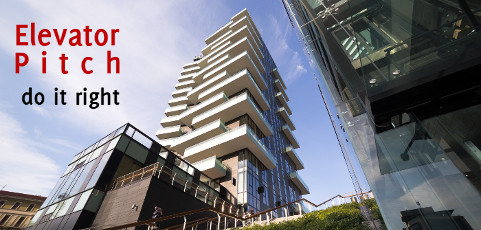Elevator Pitch, you heard it before. Is it really important or a myth?
Even if you use the stairs I believe it’s worth developing one. The idea behind it, is being able to explain people what you do, quickly, in an interesting way. This is something valuable and useful in many circumstances, including as an introduction of you (or your organisation) for a presentation or a speech.
If you are not familiar with the elevator pitch let me tell you that it’s a fairly recent term coined around 25 years ago by Ilene Rosenzweig and Michael Caruso (while he was Editor for Vanity Fair) according to Wikipedia. The idea is that you are an entrepreneur entering a lift (elevator) and you are joined by an investor. As the door close she asks you what do you do, and you should be able to say it in such a compelling way that before the doors open again she will want to follow up with you.
It’s really not only about investors or very high skyscrapers, it could be a prospect customer, and you could be having a quick exchange in a conference room. There are several scenarios where you should be able to describe your activity so that it prompts for engagement from your audience, rather than killing the conversation.
To do so you have to keep in mind what really matters, and what makes an elevator pitch effective.
First of all you need to be not boring or plain vanilla (if it was me: “I am a trainer”) and at the same time avoid incomprehensible jargon (“I am an eLearning facilitator for application deployment frameworks”).
Second, rather then focusing on what you do, start with who you do it for, and, even more important, which of your customer needs you satisfy (“I help people communicate better their messages”). Possibly add some extra benefits your customers get from working with you (“…so that they can successfully reach wider audiences and move them with little budgets”).
Last make sure you explain how you do it, for two reasons. First to avoid your pitch sounds like a pure promotional statement made out of thin air. Second, to avoid any misunderstanding, if you say you help people communicating you could do it in several ways: write copy, advertising, media company, press, public speaking, social media and some more, so make sure is crystal clear what you really do (“I coach, train and support them with public speaking, video and social media”).
In general try to be specific, pun intended. “We supply companies….” is fine, but if your customers are really only one type it’s better to clarify it: “We supply mid-size companies with export business……” or whatever they are. You want to paint a vivid picture of you or your organisation. If I say “imagine a woman” you could have a vague idea, but if I say “think about Sonia Gandhi” (or Madonna, or Princess Diana) now surely the picture is clearer, and we are on the same page.
To summarise, create your own elevator pitch. It’s helpful, it’s important and you may want also to put it on paper to use it in your written communication. To be effective first answer those questions:
- Who are your customers?
- Why they need you? (What are their needs you satisfy)
- What are the benefits they get from working with you?
- What do you do, how do you deliver your value?
Make those answers short, precise and, as I said before, specific. Add your name, your organisation and now you are ready to put together your elevator pitch.
Using myself as an example:
I am Paolo Pelloni, a Public Speaking Ambassador. My job is helping people to communicate effectively their ideas so that their messages can reach wider audiences and move them. I do it by coaching and supporting them with public speaking, presentation design, video and social media.
Yours will be different, and could be longer, but not too long. People will struggle, and possibly loose interest, in following a long windy statement. Write down yours now and then go test it, don’t do it with colleagues, try it with people that really don’t know what you do and see if they get it, if you raise interest and what questions they may have. Refine if necessary. At the end of this process you will have your own effective elevator pitch.


Recent Comments